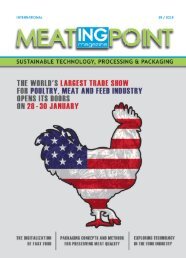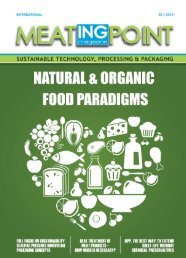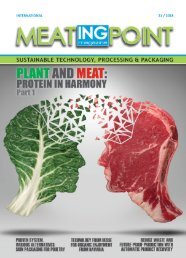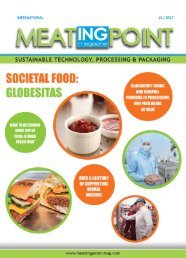MEATing POINT Magazine: #03/ 2015
- No tags were found...
You also want an ePaper? Increase the reach of your titles
YUMPU automatically turns print PDFs into web optimized ePapers that Google loves.
... PERSPECTIVES ...<br />
practically unobservable<br />
with standard data<br />
collection methods.<br />
Second, individual food<br />
consumption is influenced<br />
by disparities in intrahousehold<br />
food allocation, the variability<br />
of individual energy requirements, and the<br />
day-to-day variation in food consumption<br />
for reasons other than food insecurity<br />
(including different workloads or lifestyles,<br />
or cultural and religious habits).<br />
Moreover, the cost of implementing<br />
household surveys capable of properly<br />
estimating undernourishment in the vast<br />
majority of countries monitored by FAO<br />
on a yearly basis would be very high. At<br />
a minimum, these surveys would need to<br />
capture food consumption at the individual<br />
level and obtain sufficient information to<br />
assess habitual consumption levels. They<br />
would also need to secure information on<br />
the anthropometric characteristics and<br />
activity levels of each surveyed individual,<br />
to estimate the relevant individual<br />
energy requirement threshold. Such data<br />
requirements imply that specific surveys –<br />
different from, and much more expensive<br />
than, existing household surveys – would<br />
be needed for this purpose. In contrast,<br />
the PoU methodology allows information<br />
from household surveys to be integrated<br />
with macro data sources, such as food<br />
balances, censuses and demographic<br />
surveys.<br />
13. What is the minimum dietary energy<br />
requirement and how does FAO compute<br />
it?<br />
The minimum dietary energy requirement<br />
(MDER) is a country-specific normative<br />
threshold that FAO employs as a cutoff<br />
point to estimate the prevalence<br />
of undernourishment. The MDER is a<br />
standard energy requirement, specific for<br />
age classes and sex, derived from a joint<br />
FAO/WHO/United Nations University<br />
expert consultation held in 2001. These<br />
standards are obtained by calculating,<br />
with reference to each age class and sex,<br />
the needs for basic metabolism – that is,<br />
the energy expended by the human body<br />
in a state of rest – and multiplying them by<br />
a factor that takes into account physical<br />
activity, referred to as the physical activity<br />
level (PAL) index. The FAO methodology<br />
uses an age- and sex-weighted average<br />
standard energy requirement as a<br />
national-level MDER.<br />
14. Why does the prevalence<br />
of undernourishment indicator<br />
underestimate undernourishment by<br />
assuming a minimal level of physical<br />
activity, when, in fact, many poor people<br />
are engaged in demanding physical<br />
activities?<br />
As it is practically impossible to implement<br />
the head count approach, FAO developed<br />
the PoU estimate for the population as<br />
a whole, summarized by the statistical<br />
device of a “representative” individual.<br />
As body weight, metabolic efficiency<br />
and physical activity levels vary in any<br />
population, there is a range of values<br />
for energy requirements compatible<br />
with healthy status. Hence, only values<br />
below the minimum of such a range can<br />
be associated with undernourishment<br />
in a probabilistic sense. Thus, for<br />
the PoU to indicate that a randomly<br />
selected individual in a population is<br />
undernourished, the appropriate threshold<br />
must be set at the lower end of the range<br />
of normal energy requirements.<br />
15. What is the relationship between<br />
hunger and undernutrition?<br />
In many of our case studies, we find<br />
that although there has been significant<br />
progress in fighting undernourishment,<br />
there have been no improvements in<br />
nutritional outcomes, as measured, for<br />
instance by the proportion of children who<br />
are stunted or underweight. This means<br />
that, although people may have stable<br />
access to sufficient food for their energy<br />
needs, this food is not always of sufficient<br />
quality to provide all the necessary<br />
vitamins and other nutrients, or that some<br />
people are too ill to utilize the nutrients<br />
they consume.<br />
There are many reasons why undernutrition<br />
may occur. Lack of dietary diversity can<br />
result in undernutrition, especially where<br />
diets are poor in micronutrient-rich foods<br />
such as meat, fish and dairy products. Poor<br />
access to safe water and sanitation – both<br />
crucial for mitigating the risk of disease –<br />
can inhibit efficient food utilization. Poor<br />
education and lack of access to ante-natal<br />
and child-care facilities are also important.<br />
In many situations, nutritional supplements<br />
may be needed to improve the nutritional<br />
status of the population in the short<br />
term. A range of food security and other<br />
nutrition-enhancing interventions in<br />
agriculture, health, hygiene, water supply<br />
and education, particularly targeting<br />
women, are necessary in the medium and<br />
longer term.<br />
16. SOFI <strong>2015</strong> takes stock of uneven<br />
progress towards international hunger<br />
targets and especially the MDG 1c of<br />
halving the proportion of people that<br />
are undernourished. Why did you decide<br />
to focus on this issue?<br />
The year <strong>2015</strong> marks the end of the MDG<br />
monitoring period – about half a year<br />
remains before the deadline for achieving<br />
most of the MDG targets. It is important<br />
to examine not only the progress towards<br />
hunger reduction, but also the factors that<br />
shape this progress, which give rise to wide<br />
differences across regions and countries.<br />
SOFI identifies remaining problems and<br />
provides guidance on which policies should<br />
be emphasized in the future.<br />
17. What are these factors and why does<br />
SOFI single them out for analysis?<br />
A number of factors shape progress<br />
towards food security and nutrition<br />
goals. Economic growth, agricultural<br />
productivity growth, markets (including<br />
international trade) and social protection<br />
can all determine the pace of hunger<br />
reduction Protracted crisis situations also<br />
have detrimental effects on food security<br />
and malnutrition. This list is by no means<br />
exhaustive, but provides a good picture<br />
of what influences progress in the fight<br />
against hunger.<br />
18. SOFI mentions the economic growth<br />
is necessary for hunger reduction. What<br />
is the relationship?<br />
Economic growth is necessary for<br />
alleviating poverty and reducing hunger<br />
and malnutrition – countries that become<br />
richer are less susceptible to food insecurity.<br />
But it is not sufficient – the relationship<br />
between economic growth and hunger is<br />
complex.<br />
Looking at the numbers during the last 25<br />
years, one can see that the rate of poverty<br />
alleviation has been faster than that of<br />
hunger reduction. This is because the<br />
hungry are the poorest of the poor with no<br />
assets, no or little education and skills and<br />
are often characterized by ill health. Very<br />
poor people cannot participate in growth<br />
processes that require capital or generate<br />
employment for the educated and skilled.<br />
For example, economic growth generated<br />
by exploitation of resources, such as<br />
35

















